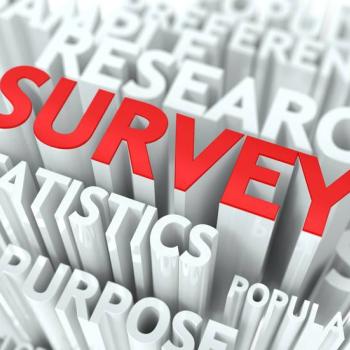And the Question Is... Writing Good Survey Questions

- Preview |
- Standards |
- Resources & Preparation |
- Instructional Plan |
- Related Resources |
- Comments
Overview
The ability to ask questions is critical to learning, and well-framed questions elicit better answers that further understanding and dialogue. However, learning to ask the right questions is a difficult skill to develop. In this lesson, students learn how to create effective questions by examining survey questions and creating their own survey on reading habits.
Common Core Standards
This resource has been aligned to the Common Core State Standards for states in which they have been adopted. If a state does not appear in the drop-down, CCSS alignments are forthcoming.
State Standards
This lesson has been aligned to standards in the following states. If a state does not appear in the drop-down, standard alignments are not currently available for that state.
NCTE/IRA National Standards for the English Language Arts
- 6. Students apply knowledge of language structure, language conventions (e.g., spelling and punctuation), media techniques, figurative language, and genre to create, critique, and discuss print and nonprint texts.
- 7. Students conduct research on issues and interests by generating ideas and questions, and by posing problems. They gather, evaluate, and synthesize data from a variety of sources (e.g., print and nonprint texts, artifacts, people) to communicate their discoveries in ways that suit their purpose and audience.
- 8. Students use a variety of technological and information resources (e.g., libraries, databases, computer networks, video) to gather and synthesize information and to create and communicate knowledge.
- 11. Students participate as knowledgeable, reflective, creative, and critical members of a variety of literacy communities.
- 12. Students use spoken, written, and visual language to accomplish their own purposes (e.g., for learning, enjoyment, persuasion, and the exchange of information).
Materials and Technology
- Computers with Internet access
- Overhead projector and transparencies (optional)
Printouts
Websites
Preparation
| 1. | Before teaching this lesson, you may want to teach its companion "And the Question Is... Evaluating the Validity of a Survey," which has students explore what makes a survey valid. |
| 2. | If you do not have classroom computers with Internet access, reserve Sessions 1 and 2 in your school's computer lab. You will need one computer for every four or five students. Familiarize yourself with all websites in the Resources list, and bookmark them on the computers students will be using if appropriate. |
| 3. | During Session 1, students will look for definitions for the following terms. You should be familiar with them and you may want to list them on the board (without the definitions).
|
| 4. | Make two or three copies of the Survey Evaluation Form for each student in your class; you may also choose to share the Example of Students' Survey Guidelines if you think it would be helpful to your students. |
Student Objectives
Students will
- Gain knowledge about the main elements to be considered when writing a survey through research and discussion
- Gain skill in analyzing survey questions by looking at a survey and analyzing it in both small- and large-group contexts and by evaluating the work of their peers
- Demonstrate comprehension of survey vocabulary by studying, discussing, and applying it to their work
- Improve questioning skills and strategies by writing their own survey questions
Session 1: Analyzing and Creating Guidelines
If you do not have classroom computers with Internet access, this session should take place in your school's computer lab.
| 1. | Tell students that they are going to create survey questions to learn about reading habits in their classroom. |
| 2. | Divide the class into heterogeneous groups of three or four, and ask students to discuss the following questions displayed on the board or overhead projector:
|
| 3. | Ask groups to share their answers with the rest of the class. During this discussion, you can explain some of the relevant vocabulary such as useful topic, purpose, respondents, questions, and format, keeping in mind that students will learn more as they read the article about survey methods. |
| 4. | Ask students to access Creating Good Interview and Survey Questions. Tell them to read the page and then to click on the links in the grey box at the bottom and read those pages as well (in particular, the page labelled Surveying). |
| 5. | Have students use information from this site, as well as A Glossary of Statistics and STEPS Statistics Glossary to search for and write down definitions for the terms listed in Preparation, Step 3. |
| 6. | As a class, discuss what students have just learned. Record definitions on the board. |
| 7. | Ask students to use the evaluation criteria in the Survey Evaluation Form to write their own guidelines for the reading surveys they will create. Ask students to use as many of the new words they just learned as possible. For reference, see Example of Students' Survey Guidelines as a model. If time allows, have students complete this assignment in the classroom. Otherwise, assign the task as homework. |
Session 2: Analyzing Survey Questions
If you do not have classroom computers with Internet access, this session should take place in your school's computer lab.
| 1. | Ask students to form groups of three or four and share the guidelines they created during the previous session or as homework. |
| 2. | Allow some time for this activity, and then ask each group to share its guidelines with the rest of the class. You might sketch on the board the results of this discussion in order to arrive at a final and general guide for the whole class. Ask students to take notes and keep the guidelines for further use. |
| 3. | Next, tell students they will be creating their own surveys to gather information about the reading habits of their classmates. To prepare for this activity, students will work in small groups or pairs and will visit the Read On Reading Connects survey (found on page 47), which contains a questionnaire created by the British National Literacy Trust organization about the reading habits of school children. Ask students to analyze the survey using the class-created guidelines. Their goal is to discover what makes a good question for a survey. |
| 4. | Display the following questions on the board or overhead projector, and discuss them as a whole class:
|
Homework: Ask students to record in their journals their thoughts about what they learned from the survey analysis.
Session 3: Creating a Survey
Divide the class into heterogeneous groups of three or four. Ask students to create their own survey questions to assess the reading habits of their classmates. Remind students to use the guidelines created by the whole class and the results of their own analysis during Session 2.
This activity will take the entire class time. Make sure all groups finish their surveys by the end of the class. Otherwise, ask them to finish them as homework.
Session 4: Conclusions and Pilot Testing
| 1. | Ask students to exchange their surveys with other groups and to analyze the surveys in the same manner they analyzed the one in Session 2. |
| 2. | As a whole class, discuss the validity of the surveys. |
| 3. | Ask students to pilot test their surveys within their groups. Students can respond to their own surveys or one from another group. |
| 4. | Collect the surveys and answers to see what students have done and ensure that they understood the task. |
Homework: Ask students to write in their journals as they reflect on how analyzing survey questions and asking their own questions helped them learn more about crafting questions.
Extensions
Have students work through the activities in the Science NetLinks lesson "Bias Sampling."
Student Assessment / Reflections
Monitor students’ participation in class and group discussions and use the Teacher’s Rubric for Assessing Students’ Participation and Survey Questions to assess what students learned about surveys and how they applied it to their own work.
